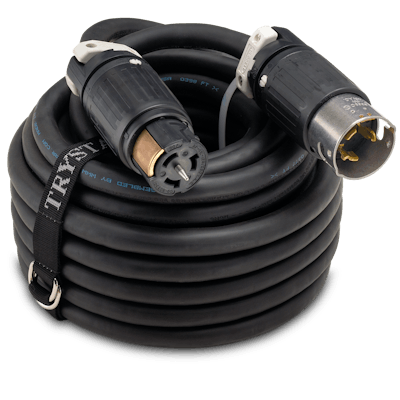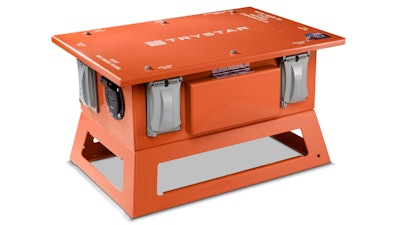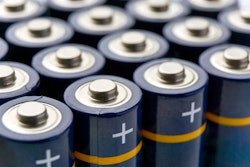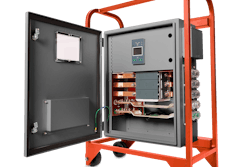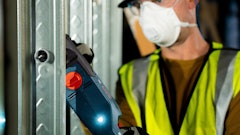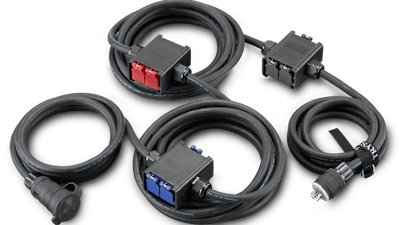
As last winter’s events in Texas demonstrated, the portable and emergency power market represents an excellent growth opportunity for independent rental operations. If you already own towed gensets in the typical 25 to 60 kW range, adding a package of cables, connectors, and accessories is an obvious way to increase per-rental income while providing a more comprehensive service to your customers.
But, if you don’t speak “electrician” fluently, the industry terminology and broad range of product specifications can make assembling a practical and economical package a challenge. Fortunately, there are only a few things you really need to know and they’re not all that complicated when put in layman’s terms.
Understanding the Pieces
Let’s start with connectors:
- California Twist Lock – This is used to connect a cable to a receptacle on the generator. It’s easy to recognize because the receptacle has a “spike” in the center with slots arranged in a circle around it. For a typical 25 to 60kW generator, you will need one rated for 50 amp service for each receptacle on the generator.
 California Twist Lock
California Twist Lock - Camlock –This typically is used to connect larger generators to equipment intended to support high-demand applications up to 400 amps. Each connector carries current from a single pole, which means that a typical connection will use several Camlock connectors and cables.
- NEMA – The National Electrical Equipment Manufacturers Association (NEMA) develops standards for a broad range of electrical equipment and applications, in this case for electrical connectors. The NEMA connectors you are most likely to encounter are the two- or three-prong connectors commonly seen on tools and appliances connected to standard AC power sources. They can be configured with straight prongs for direct insertion or with curved twist-to-lock prongs. The most common examples are rated for 20 or 30 amps.
Of course, connectors aren’t much use without cables. These are designated by the number of individual conductors in the cable and the wire size that's expressed according to American Wire Gauge (AWG) standards. You will see designations like 6/4, 2/5, and 12/5. It’s somewhat counterintuitive, but the smaller the AWG size, the larger the wire itself. Thus, an AWG 0 is larger than an AWG 5.
The other thing to look for is the ability of the jacket material to withstand things like sunlight, oil, ozone, acid, and water. The most practical cables for general purpose use will be labeled SOOW meaning they are resistant to sunlight, oil, ozone, and water.
Unless the total output of the generator is going to be connected to a single load, you will need some kind of power distribution hardware to convert the single input into multiple outputs. There are three basic way to accomplish this:
- Spider Box – This is a small, highly portable accessory that is connected to the generator and contains multiple circuit breakers and output receptacles to service several different loads. For 25 to 60 kW generators with built-in California Twist Lock receptacles, the spider box typically uses the same connector for input. A broad range of output options are available, but the most common are GFCI and NEMA receptacles.
 Spider Box
Spider Box - Power Distribution Panel – This is essentially a big spider box that is able to handle much higher loads. It typically would be connected to the generator with Camlocks rather than California Twist Locks. Up to 10 spider boxes can be connected to a single Power Distribution Panel.
- I-Line – This is essentially a very large power distribution panel suitable for loads up to 3,000 amps.
Putting it all Together
Starting at the generator, a basic accessory package would include a 50-foot 6/4 SOOW rated cable with 50 amp California Twist Lock connectors on both ends. If the generator has two receptacles, then two cables are required. Each generator cable is connected to a spider box input receptacle with the other California Twist Lock.
Usually, 50-foot cables are recommended to provide maximum flexibility in locating the generator and distribution accessories. Anything shorter limits placement options and anything longer becomes increasingly difficult to handle. Fifty feet is the sweet spot, and they can be daisy chained to reach any practical desired length.
The spider box should be specified with a 50 amp circuit breaker at the input to protect everything downstream. The most useful outputs for general applications are 20 amp, 120 volt GFCI and 30 amp, 250 volt twist lock receptacles. A typical Trystar spider box will provide up to six GFCI duplex receptacles and one 250-volt receptacle, all protected with individual circuit breakers and other manufacturers products are similar.
Extension cords to power end-user requirements can be plugged directly into the spider box. Where many devices need to be powered, Trystar recommends a Quad Box Stringer cable that combines three independent circuits each powering a dual outlet box into a single unit.
Moving to the Next Level
While a basic package of cables and spider boxes will serve the needs of most applications requiring 25 to 60 kW generators, there are many rental opportunities for larger equipment that also can be serviced with a just a few add-ons.
Large generators don’t typically have permanent receptacles for California Twist Locks, but require cables to be hard wired to bus bars. In that case, a “Pig Tail” with bare wire on one end and a Camlock on the other is required. The generator cable would be connected to a Power Distribution Panel or an I-Line, and that output would then feed either spider boxes or high end-user loads directly.
If a large generator is already in your rental fleet, or one is planned for the future, then a relatively small additional expense would open a wide range of opportunities. And if it isn’t, a basic package of cables and spider boxes will still let you grow per-rent income from your existing generators and provide a more comprehensive service offering to your customers. Either way, it’s a win-win.

